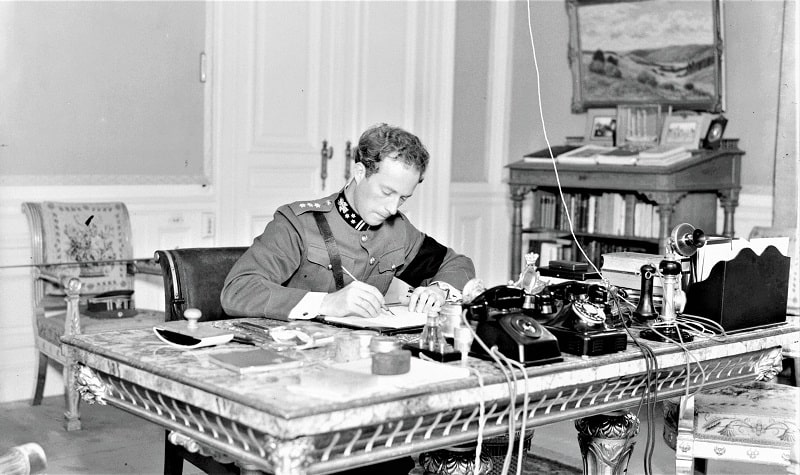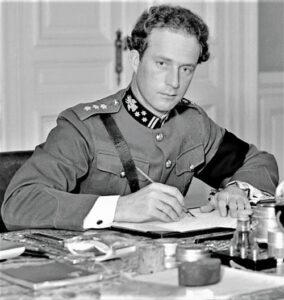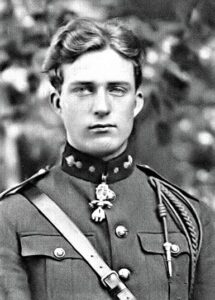
Leopold III (Dutch: Leopold Filips Karel Albert Meinrad Hubertus Maria Miguel; Born on November 3, 1901, in Brussels, Belgium – Death on September 25, 1983, in Woluwe-Saint-Lambert, Brussels, Belgium) was the 4th King of Belgium from 1934 until 1951. Leopold III comes from the noble family of Belgium called Saxe-Coburg and Gotha.
Leopold III is remembered today as one of the main heroes of Belgium during World War I for the great courage shown by taking the front line alongside his father’s soldiers.
But he is also remembered for having been one of the most politically controversial figures on the European scene during World War II when his autocratic character made him disliked by the government of the country and a large part of its population, as well as by the European allied powers.
In July 1951 under government pressure, he abdicated in favor of his son, Prince Baudouin. Leopold III formally resigned on July 16, 1951, after Baudouin turned 21.

Quick Facts of Leopold III
- Born: 3 November 1901, Brussels, Belgium
- Known for: Leopold III of Belgium
- Also known As: Leopold Filips Karel Albert Meinrad Hubertus Maria Miguel
- Reign: 17 February 1934 – 16 July 1951
- Predecessor: Albert I
- Successor: Baudouin
- Regent: Prince Charles (1944–1950)
- Parents: Father – Albert I of Belgium, Mother – Duchess Elisabeth in Bavaria
- Religion: Roman Catholicism
- House: Saxe-Coburg and Gotha (until 1920)
- Full name:-
Dutch: Leopold Filips Karel Albert Meinrad Hubertus Maria Miguel
French: Léopold Philippe Charles Albert Meinrad Hubert Marie Michel
German: Leopold Philipp Karl Albrecht Meinrad Hubert Maria Michael - Spouse: Princess Astrid of Sweden (m. 1926; died 1935), Mary Lilian Baels (m. 1941)
- Died: 25 September 1983 (aged 81) Woluwe-Saint-Lambert, Brussels, Belgium
- Burial: Church of Our Lady of Laeken
Early Life of Leopold III
Prince Leopold was born on 3rd November 1901 in Brussels, Belgium as the first son of Crown Prince Albert of Belgium and his wife, Princess Elisabeth of Bavaria. The young prince grew up with his younger brothers Prince Charles and his younger sister Maria José, in a loving and stimulating family environment.
The parents, as culture lovers as they were, passed on to their children the passion for knowledge, giving them an unconventional type of education, made up of frequent trips abroad and numerous readings, both classic and contemporary.
The three brothers were always surrounded by musicians, writers, and scientists, for the most part, close friends of the parents themselves. When his father became king of Belgium in 1909, Leopold, as crown prince, immediately began to publicly attend alongside the new sovereign, to whom he was particularly close during the years of the First World War.

With a great spirit of personal sacrifice, which earned him the esteem and admiration of his people for life, at just 13 years old, the young heir to the throne asked to be enlisted in the ranks of the Belgian army, obtaining to be placed in the 12th battalion of line infantry with which he took part in the Great War.
At the end of the conflict, in 1918, he enrolled at the St. Anthony Seminary University of Santa Barbara in California, thus having the opportunity to study abroad. During this period, from 23 September to 13 November 1919, the young Prince Leopoldo officially joined the family on a state visit to the United States.
First Marriage
On November 4, 1926, in Stockholm, he married Princess Astrid of Sweden, granddaughter of King Oscar II of Sweden and King Frederick VIII of Denmark. They had three children:
- Josefina Carlota, later Grand Duchess of Luxembourg (1927-2005); With offspring.
King of the Belgians
Accession to the throne
He became king of the Belgians in February 1934, when his father died of a fall while practicing mountaineering. Under the name of Leopold III of Belgium.
Death of Queen Astrid
On August 29, 1935, King Leopoldo III and Queen Astrid were driving along the roads of Küssnacht (Switzerland), near the lake of the Four Cantons, when he lost control of the car, causing an accident that killed his wife.
The death of popular queen Astrid is felt like a particularly painful national mourning.
Second marriage
On September 11, 1941, King Leopold III entered into a secret morganatic marriage with Lilian Baels (1916-2002), who later received the title of Princess de Reti, with whom he had three children:
- Prince Alexander (1942-2009);
- Princess Maria-Christina (born 1951);
- Princess Maria Esmeralda (born 1956).
World War II
When World War II broke out in September 1939, the French and British governments tried to persuade Belgium to join them. Leopold and his government refused, keeping Belgium neutral.
Belgium considered itself well prepared for a possible Axis invasion, as the Belgian government made extensive preparations in the 1930s to contain and repel a German invasion of the country, such as the one that took place in 1914.
On May 10, 1940, the Wehrmacht invaded Belgium. After a short battle, Belgium was overwhelmed by the more numerous and better prepared Germans. On May 24, 1940, Leopold met his ministers for the last time, taking command of the Belgian army. The ministers called on the king to leave the country with the government.
Prime Minister Hubert Pierlot reminded him that the capitulation was a decision of the Belgian government, not the king. The king indicated that he chose to stay in Belgium with his troops, regardless of the consequences.
Ministers took this as a sign that he would form a new government under Hitler’s leadership, which could be a betrayal. Leopold, on the other hand, claimed that he could be seen as a defector if he left the country: “Whatever happens, I must share the same fate as my soldiers”.
Leopold has long had a difficult and controversial relationship with his ministers, acting independently of government influence whenever possible and trying to circumvent or even curtail ministers’ powers while extending his own.
French, British and Belgian troops were surrounded by German forces during the Battle of Dunkirk. Leopold notified King George VI by telegram on May 25, 1940, that Belgian forces had been crushed, saying that “the aid we are giving to the Allies will end if our army is surrounded”.
Two days later, Leopold surrendered the Belgian forces to Germany. After the military surrender, Leopold remained in Brussels to surrender to the invaders while his entire civilian government departed in exile in Paris and later in London.
Life after Abdication
After his abdication in 1951, Leopold was able to dedicate himself to his passions, such as anthropology and entomology, and traveled the world. He went, for example, to Senegal and strongly criticized the French decolonization process.
Death of Leopold III
In 1983, King Leopold III died at the age of eighty-one. His body was buried in the royal deposit, near the tomb of Queen Astrid, in the Church of Our Lady of Laeken. The Princess Lilian of Belgium, Princess of Réthy, who died in 2002, was buried in the churchyard.